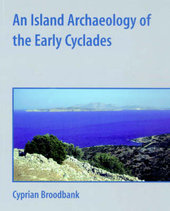
|
An Island Archaeology of the Early Cyclades
Paperback / softback
Main Details
| Title |
An Island Archaeology of the Early Cyclades
|
| Authors and Contributors |
By (author) Cyprian Broodbank
|
| Physical Properties |
| Format:Paperback / softback | | Pages:436 | | Dimensions(mm): Height 237,Width 190 |
|
| Category/Genre | Prehistoric archaeology
Classical Greek and Roman archaeology |
|---|
| ISBN/Barcode |
9780521528443
|
| Classifications | Dewey:939.15 |
|---|
| Audience | | Professional & Vocational | |
|---|
| Illustrations |
14 Tables, unspecified; 97 Maps; 71 Halftones, unspecified; 15 Line drawings, unspecified
|
|
Publishing Details |
| Publisher |
Cambridge University Press
|
| Imprint |
Cambridge University Press
|
| Publication Date |
18 July 2002 |
| Publication Country |
United Kingdom
|
Description
This book uses comparative island archaeology to reinterpret a vital phase in early Aegean history. Cyprian Broodbank presents the first modern analysis of Cycladic culture, tracing the development of Neolithic and Early Bronze Age societies in these islands from first colonisation through to incorporation, three millennia later, in the world system of the Minoan palaces and the wider Near East. The archaeology of this region is rich and well documented, and allows Dr Broodbank to reformulate early Cycladic history and to deploy detailed examples that challenge established approaches to island archaeology. He shows that islanders can actively define their cultural space and environments, and that their communities are linked by complex relations to the non-insular world. This book provides fresh perspectives and challenges for island archaeologists and Mediterranean specialists.
Reviews'What makes this a really significant contribution to our understanding of Aegean prehistory, in addition to the excellence and freshness of the writing, is a coherence and originality of analysis which sets new standards for a regional study not only in the Aegean but more widely. It is meticulous in its detail, rich in insights and deserves to be read for its analytical sweep by archaeologists and prehistorians far beyond the Cyclades.' Journal of Hellenic Studies
|